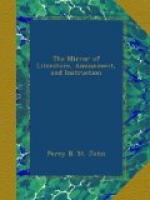In this state it is called slip, and is now evaporated to a proper consistence in long brick troughs. It is then tempered in the pug-mill, which is an iron cylinder placed perpendicularly, in which an arbor or shaft revolves, having several knives projecting from it, the edges of which are somewhat depressed. By the revolution of these the clay is cut or kneaded, and finally is forced by their action through a hole in the bottom of the cylinder, and is now ready for use. Cups, pots, basins, and other round articles, are turned rough on the horizontal potter’s wheel; and, when half dried, are again turned in a lathe. They are then fully dried in a stove, and the remaining roughnesses are afterwards removed by friction with coarse paper. Articles that are not round, and the round ones that have embossed designs on their surface, are made of thin sheets of clay rolled out like dough, and then pressed into moulds of plaster of Paris; the moulds being previously dried, absorb the superficial moisture of the clay, and thus allow it to part from them without injury. The two or three separate pieces composing the article are then united by means of fluid slip. Spouts and handles of jugs and tea-pots are made and united with the body of the vessel in the same way. Small handles, beadings, mouldings, &c. are formed by means of an iron cylinder, having its bottom perforated so as to mould the clay, as it passes through, into the required figure. A piston is inserted into the top of the cylinder, and caused to descend slowly by means of a screw, in consequence of which the clay is continually passing out through the perforation, and is cut off in lengths.
Plates are beaten or rolled out of a lump of clay, and are then laid on a mould turned to the shape of the upper surface of the plate. A rotatory motion is given to the mould, and an earthenware tool representing a section of the plate is pressed upon it; thus the plate is made smooth, has a uniform thickness given to it, and it takes a perfect cast of the mould. Cups, saucers, and basins, when rough-turned, are dried on the block to prevent them from warping.
The ware being thoroughly dried, is packed into saggars and burnt in the furnace to biscuit. Patterns for flat, or nearly flat surfaces, are put on by printing the pattern from a copper-plate with an ink composed of oxide of cobalt, oxide of iron, or other colouring matter, mixed with oil. The impression is taken on soft paper, and is applied to the surface of the biscuit, and slightly rubbed to make the print adhere: the biscuit is then soaked in water till the paper may be stripped off, leaving the print or pattern behind[12]. The ware is then dipped in the glaze, which is a mixture of flint slip and white lead, and the bibulous quality of the biscuit causes a sufficient quantity to adhere: the piece is then dried and again passed into the furnace, which brings out the colours of the pattern, and at the same time vitrifies the glaze.




